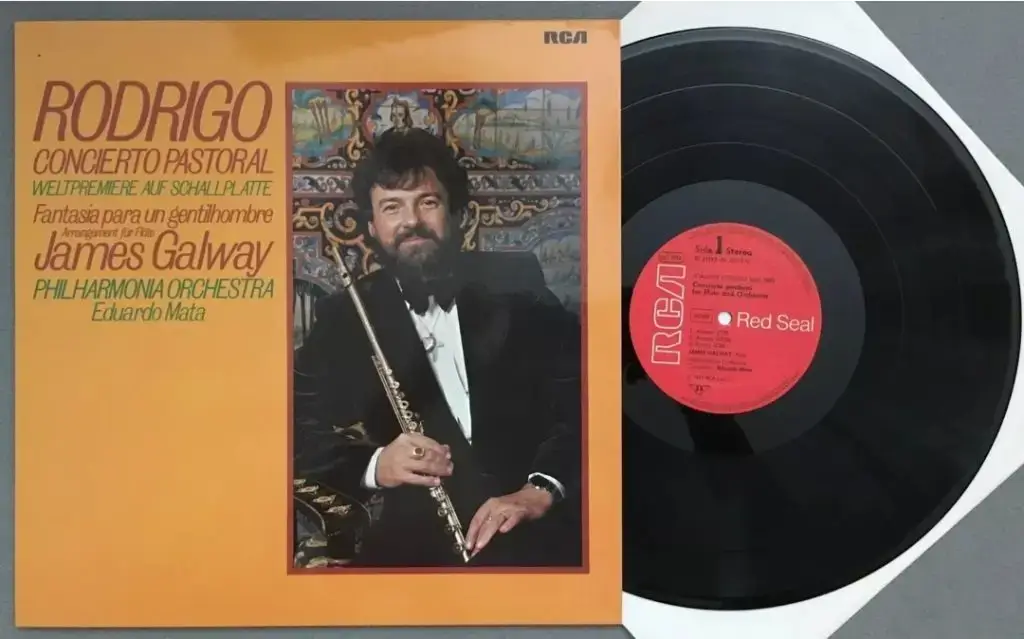
The Premiere of Joaquín Rodrigo’s Concierto pastoral
Joaquín Rodrigo’s Concierto pastoral is one of the most celebrated flute concertos of the 20th century, embodying the spirit of Spanish music through its vibrant rhythms, melodic beauty, and evocative orchestration. Composed in 1978, the concerto was written for the renowned flutist James Galway, who became one of Rodrigo’s most ardent champions. The work stands as a testament to Rodrigo’s ability to infuse classical forms with the distinct flavors of Spanish folk music, making it a significant contribution to both the flute repertoire and contemporary Spanish music.
The First Performance
The Concierto pastoral was premiered on October 17, 1978, at the Teatro Real in Madrid, with James Galway as the soloist, accompanied by the Spanish National Orchestra under the direction of Rafael Frühbeck de Burgos. The premiere was a highly anticipated event, not only because of Galway’s international fame but also due to Rodrigo’s stature as one of Spain’s most revered composers.
Galway’s performance was met with widespread acclaim, showcasing his technical brilliance and deep understanding of Rodrigo’s musical language. The concerto was praised for its challenging yet idiomatic writing for the flute, as well as for its ability to evoke the landscapes and sounds of Spain through music.
Structure and Musical Content
The Concierto pastoral is structured in three movements:
Allegro: The first movement is lively and energetic, characterized by its rhythmic vitality and dance-like themes. Rodrigo employs a variety of Spanish folk dance rhythms, giving the movement a distinctively Iberian flavor. The flute part is virtuosic, with rapid passages, intricate articulations, and soaring melodies that require both technical prowess and expressive nuance.
Adagio: The second movement is deeply lyrical and reflective, offering a contrast to the exuberance of the first. It features a hauntingly beautiful melody that unfolds over a delicate orchestral accompaniment. The flute’s role in this movement is to convey a sense of introspection and melancholy, with long, flowing lines that showcase the instrument’s ability to sustain and shape a phrase with great sensitivity.
Rondo: The final movement returns to the lively and spirited character of the first, with a playful and rhythmic theme that is developed through a series of variations. Rodrigo incorporates elements of Spanish folk music, including the use of castanet-like rhythms and rapid, dance-like figures. The movement culminates in a dazzling cadenza that allows the flutist to display their full range of technical skills before bringing the concerto to an exhilarating conclusion.
Importance and Legacy
Rodrigo’s Concierto pastoral is a significant work in the flute repertoire, celebrated for its fusion of classical forms with the rich traditions of Spanish folk music. The concerto’s premiere solidified its place as a contemporary masterpiece, and it has since become one of the most frequently performed and recorded flute concertos.
The work is particularly important for its role in showcasing the flute as a solo instrument in the context of 20th-century music. Rodrigo’s writing is both idiomatic and innovative, pushing the boundaries of what was traditionally expected from the flute while remaining accessible and engaging for audiences.
The Concierto pastoral also holds a special place in James Galway’s career, as it was written specifically for him and became one of his signature pieces. Galway’s advocacy for the work has contributed to its enduring popularity, and it remains a favorite among flutists worldwide.
Conclusion
The premiere of Joaquín Rodrigo’s Concierto pastoral in 1978 was a landmark event in contemporary music, introducing a work that continues to captivate flutists and audiences alike. James Galway’s performance at the Teatro Real in Madrid brought the concerto to life, highlighting its technical challenges and expressive depth. Today, the Concierto pastoral is celebrated not only as a masterpiece of the flute repertoire but also as a vibrant and enduring example of Rodrigo’s ability to blend classical forms with the rich traditions of Spanish music.
Watch the premiere of Rodrigo's Concerto
Premiere of Joaquín Rodrigo’s Concierto pastoral

